Onykia sp. A
Richard E. YoungIntroduction
Wakabayashi et al. (2007) found a paralarval Onykia near Hawaii (28°30'N 155°W at a surface temperature of 23.3°C) that could not be assigned to any know species of the genus from the North Pacific based on molecular analysis of the COI gene. Therefore, we suspect that Onykia sp. A, found commonly in waters around the main Hawaiian Islands but known primarily from paralarvae, is a new species. A nearly mature female taken from the stomach of a sword fish with a small size further supports this possibility.
Brief diagnosis:
An Onykia with ...
- small maximum size (?)
- irregular warts on mantle (?)
Characteristics
The following information is from the nearly mature female (272 mm ML, see title photograph) taken, partly digested, from the stomach of a swordfish.- Arms
- Arm tips very attenuate.
- Arm tips very attenuate.
- Tentacles
- Right club with about 25-26 hooks, left club with about 22 hooks.
- Head
- Beaks: Descriptions can be found here: Lower beak; upper beak.
- Funnel groove with inverse Y-shaped ridge.
- Mantle
- Mantle appears to have been covered with round/irregular warts.
- Fins
- Fins sagittate; extend to posterior tip of tail.
- Fins sagittate; extend to posterior tip of tail.
- Viscera
- Gladius rostrum of 272 mm ML female: 45 mm long, measured from ventral edge of conus.
- Irregular shape in cross-section.
- Nidamental and oviducal glands well developed.
- Measurements:
*Measured to tip of tail.Female
mm
Mantle length
272
Head width
34
Funnel lock, lenght
25 Mantle lock, length
45 Arm I, length
152
Arm II, length
170 Arm III, length
178 Arm IV, length
188 Tentacle length
400 Club length
68 Fin length*
145
Fin width
150
Comments
Onykia sp. A is similar to the the warm water O. robsoni/O.carriboea but cannot be clearly separated from them at present.
Life History
The paralarvae of Onykia sp. A (Figs. A-C below) are easily distinguished from other squid paralarvae in Hawaiian waters: They are broad and have a characteristic line of large dorsal mantle chromatophores whose widths generally increase posteriorly. Small paralarvae often are observed in preserved samples with the head mostly withdrawn into the mantle cavity as shown in Fig. A.
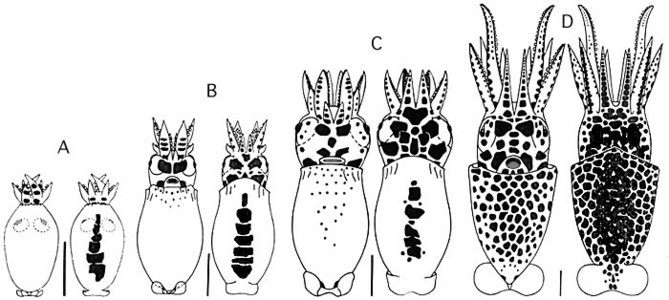
Figure. Ventral and dorsal views of paralarvae and an early juvenile of Onykia sp. A - 1.7 mm ML paralarva. B - 2.7 mm ML paralarva. C - 3.4 mm ML paralarva. D - 5.6 mm ML juvenile. A-C show paralarvae with contracted anterior mantle margins which are commonly observed in preserved paralarvae. These growth stages were taken from plankton tows in Hawaiian waters. The scale bar is 1 mm. Drawings by R. Young.
References
Wakabayashi, T., T. Kubodera, M. Sakai, T. Ichii, and S. Chow. 2007. Molecular evidence for synonymy of the genera Moroteuthis and Onykia and identification of their paralarvae from northern Hawaiian waters. Journal of the Marine Biological Association of the UK, 87: 959-965.
Title Illustrations

| Scientific Name | Onykia sp. A |
|---|---|
| Comments | Squid taken from the stomach of a swordfish |
| Sex | Female |
| Life Cycle Stage | Nearly mature |
| View | Side |
| Size | 272 mm ML |
| Collector | Anela Choy |
| Image Use |
 This media file is licensed under the Creative Commons Attribution License - Version 3.0. This media file is licensed under the Creative Commons Attribution License - Version 3.0.
|
| Copyright |
©

|
About This Page

University of Hawaii, Honolulu, HI, USA
Correspondence regarding this page should be directed to Richard E. Young at
Page copyright © 2011
 Page: Tree of Life
Onykia sp. A.
Authored by
Richard E. Young.
The TEXT of this page is licensed under the
Creative Commons Attribution-NonCommercial License - Version 3.0. Note that images and other media
featured on this page are each governed by their own license, and they may or may not be available
for reuse. Click on an image or a media link to access the media data window, which provides the
relevant licensing information. For the general terms and conditions of ToL material reuse and
redistribution, please see the Tree of Life Copyright
Policies.
Page: Tree of Life
Onykia sp. A.
Authored by
Richard E. Young.
The TEXT of this page is licensed under the
Creative Commons Attribution-NonCommercial License - Version 3.0. Note that images and other media
featured on this page are each governed by their own license, and they may or may not be available
for reuse. Click on an image or a media link to access the media data window, which provides the
relevant licensing information. For the general terms and conditions of ToL material reuse and
redistribution, please see the Tree of Life Copyright
Policies.
- First online 02 March 2011
- Content changed 08 March 2011
Citing this page:
Young, Richard E. 2011. Onykia sp. A. Version 08 March 2011 (under construction). http://tolweb.org/Onykia_sp._A/137607/2011.03.08 in The Tree of Life Web Project, http://tolweb.org/




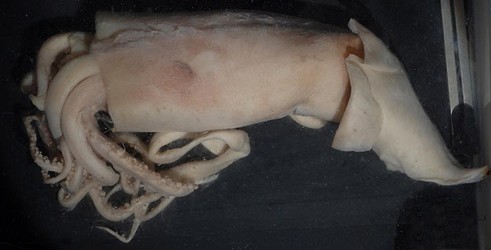
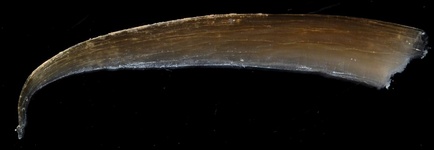
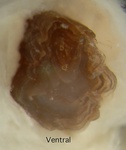
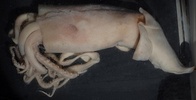


 Go to quick links
Go to quick search
Go to navigation for this section of the ToL site
Go to detailed links for the ToL site
Go to quick links
Go to quick search
Go to navigation for this section of the ToL site
Go to detailed links for the ToL site